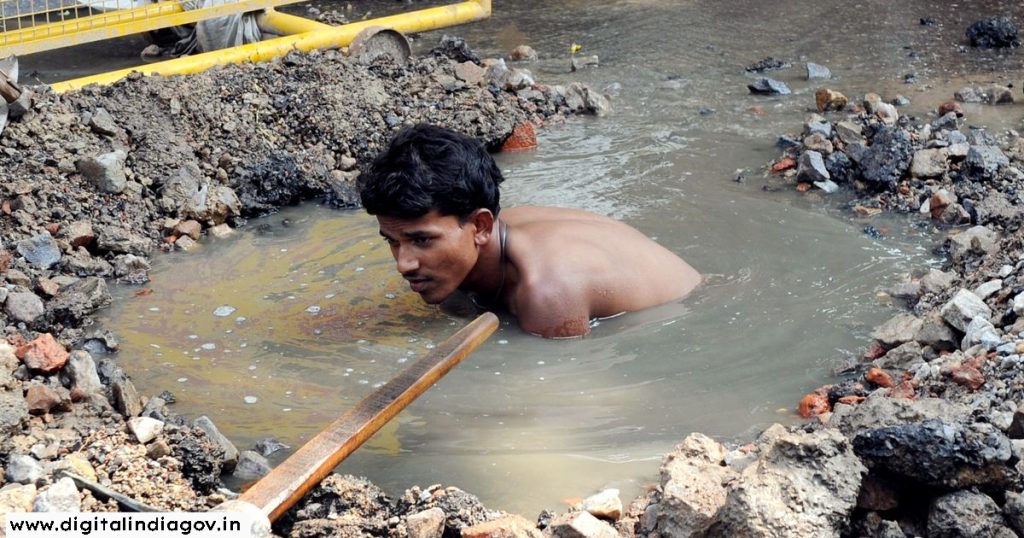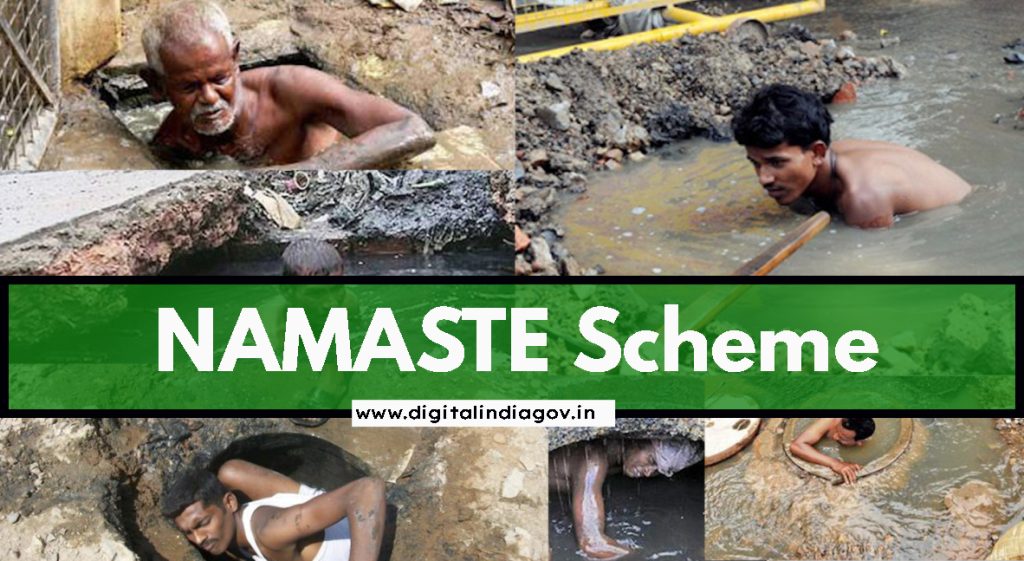NAMASTE Scheme:- NAMASTE, or the National Action for Mechanised Sanitation Ecosystem, is an initiative to safeguard the safety of sanitation workers. The Plan, which will cost Rs. It has been authorized to spend 360 crore over four years, from 2022–2023 to 2025–2026. The NAMASTE Scheme has received roughly Rs 100 crore in funding from the Union Budget for 2023–2024. This post will teach you about the NAMASTE Scheme, a subject that is crucial to the IAS test.
Contents
What is the NAMASTE Scheme
By establishing an environment that acknowledges sanitation workers as essential contributors to the upkeep and operation of sanitation infrastructure, the plan aims to ensure the safety and dignity of sanitation workers in urban India.
- By increasing capacity and improving access to safety equipment and machinery, it seeks to improve occupational safety for sanitation workers while also supplying a sustainable means of subsistence.
- It is expected that the program will change the public’s perception of sanitation workers and raise the demand for services related to clean sanitation.
- The Namaste Scheme has replaced the self-employment Scheme for Rehabilitation of Manual Scavengers (SRMS), which was first implemented in 2007. Rehabilitating manual scavengers and their dependents into other professions was the aim of SRMs.
- 500 cities that have received notification under the AMRUT Scheme (Atal Mission for Rejuvenation and Urban Transformation) will see the implementation of the program.

Also Read:- Disadvantages Of Senior Citizen Savings Scheme, Digitize India, Digitize India Platform, Work From Home Jobs, Celebrity Phone Number
Objectives of NAMASTE
The following goals serve as the foundation for NAMASTE:
- attaining zero deaths in India’s sanitation efforts.
- ensuring that competent personnel carry out all sanitation-related tasks.
- avoiding direct touch between sanitation workers and human waste.
- empowering sanitation workers by allowing them to manage sanitation businesses and encouraging collectivization into Self-Help Groups (SHGs).
- Allowing sanitation workers who deal with septic tanks and sewers to have access to alternate sources of income.
- Strengthening national, state, and urban local body (ULB) mechanisms for oversight and monitoring is necessary to enforce and oversee proper sanitation work.
- educating those in need of sanitation services on the value of hiring certified and experienced sanitation personnel.
Implementation of NAMASTE
500 cities, including those under the Atal Mission for Rejuvenation and Urban Transformation (AMRUT), will adopt the NAMASTE Scheme. Cities that qualify include:
- Every city and town with more than one lakh population, as well as the Municipalities that have been informed and the Cantonment Boards (Civilian areas).
- Capital cities of states and union territories not covered by the previous category.
- Ten cities from islands, hill states, and popular tourist spots (no more than one from each State).

Also Read:- Nrega Job Card New List 2024
Benefits of NAMASTE for Workers
Sanitation workers can benefit from multiple programs offered by NAMASTE, such as:
- Sewer and septic tank workers are listed.
- Ayushyaman Bharat-Pradhan Mantri Jan Arogya Yojana (AB-PMJAY) should include designated sanitation workers and their families as a safety net.
- aid with a livelihood through enterprise development and mechanization.
- extending benefits to sanitation workers and their families under various social security programs.
- all-encompassing assistance with prospects for self-employment and skill development.
- financial assistance and subsidies for the purchase of vehicles and equipment connected to sanitation.
NAMASTE Scheme aims to achieve the following outcomes:
- No deaths from work related to sanitation.
- Professionals should handle all hygienic tasks.
- no direct coming into contact with human excrement.
- Employees in the sanitation industry are organized into Self Help Groups (SHGs), which are given the authority to manage businesses involved in sanitation.
- All sanitation workers (SSWs) who deal with septic tanks and sewers have access to alternate sources of income.
- enhanced oversight and surveillance frameworks at the federal, state, and local government levels to guarantee the implementation and oversight of safe sanitation practices.
- greater awareness among those in need of sanitation services—both individuals and organizations—about the importance of using licensed and knowledgeable sanitation professionals.
NAMASTE Scheme Features
The main components of the Namaste scheme that each ULB will implement are as follows:
- Enumeration: NAMASTE plans to list all Sewer/Septic Tank Workers (SSWs) involved in potentially dangerous cleaning tasks. Survey administration is done by the City NAMASTE Managers, and the related ULBs validate the results.
- Providing SSWs with PPE (Personal Protective Equipment) kits and occupational training.
- Support for SRUs’ (Sanitation Response Units) safety equipment.
- Benefit Extension under Insurance Scheme: Under AB-PMJAY (Ayushman Bharat – Pradhan Mantri Jan Arogya Yojana), recognized SSWs and their families would receive coverage as a safety net.
- Support for Livelihoods: The action plan will encourage the growth of businesses and mechanization. In order to purchase vehicles and sanitation-related equipment for the complete mechanization of cleaning operations, the National Safai Karamchari Financial Development Corporation (NSKFDC) will offer funding support and subsidies (capital + interest) to the sanitation workers, SHGs of SSWs, and Private Sanitation Service Organisations (PSSOs).
- Campaigns for Information, Education, and Communication (IEC) – to publicize awareness-raising efforts that the NSKFDC and ULBs will be working on together.
National NAMASTE Management Unit
The National Safai Karamchari Financial Development Corporation (NSKFDC) is responsible for implementing NAMASTE at the national level. This program is jointly handled by MoSJE and MoHUA, and it has a dedicated national team. Important elements consist of:
- For efficient tracking and reporting, use the National NAMASTE Monitoring Unit (NNMU).
- Specialists from many fields form a Technical Support Unit (TSU) to aid in planning and implementation.
State NAMASTE Management Unit
To oversee the State Namaste Management Unit (SNMU), each State Government appoints a State Namaste Director. This person may have affiliations with the National Urban Livelihood Mission (NULM), Atal Mission for Rejuvenation and Urban Transformation (AMRUT), and Swachh Bharat Mission (SBM), among other State departments.
City NAMASTE Monitoring Unit
In groups of municipalities, the Project Management Unit is organized at the city level to perform the duties of City NAMASTE Monitoring Units (CNMU). These organizations use money from MoHUA programs to pay for a range of activities, including the creation of Self-Help Groups (SHGs), the purchase of safety equipment, PPE, and programs aimed at developing skills.
Significance of NAMASTE
The NAMASTE Scheme is extremely important in a number of ways.
- By increasing capacity and improving access to safety equipment and machines, it seeks to improve the safety of sanitation workers while also giving them a sustainable means of subsistence.
- By granting access to alternative livelihood assistance and rights, NAMASTE aims to interrupt the intergenerational cycle of sanitation employment and lessen the vulnerabilities faced by sanitation workers.
- It aims to alter public perceptions about sanitation workers in order to increase demand for hygienic sanitation services.

Also Read:- Agneepath Scheme Apply
FAQ’s
Q. The Namaste scheme: what is it?
Ans- NAMASTE, or the National Action for Mechanised Sanitation Ecosystem, is an initiative to safeguard the safety of sanitation workers. The Plan, which will cost Rs. approved to cost 360 crore and span four years, from 2022–2023 to 2025–2026. The NAMASTE Scheme has received roughly Rs 100 crore in funding from the Union Budget for 2023–2024.
Q. Who is the Namaste scheme’s nodal agency?
Ans- National SafaiKaramcharis Finance & Development Corporation Limited (NSKFDC) is the scheme’s implementing agency. The 4861 ULBs (all Cities and Towns, including the Cantonment Board (Civilian regions)) will all implement the NAMASTE scheme.
Conclusion
In India, there is an urgent need to address the safety and dignity of sanitation workers. This led to the creation of the NAMASTE Scheme. Sanitation workers have historically faced discrimination and mortality; they should be able to live with dignity and have access to safety precautions. That is precisely what NAMASTE seeks to give them, guaranteeing a brighter future for those who are essential to the upkeep of our sanitary infrastructure.
Suggested Link:- Our Jharkhand
@PAY
